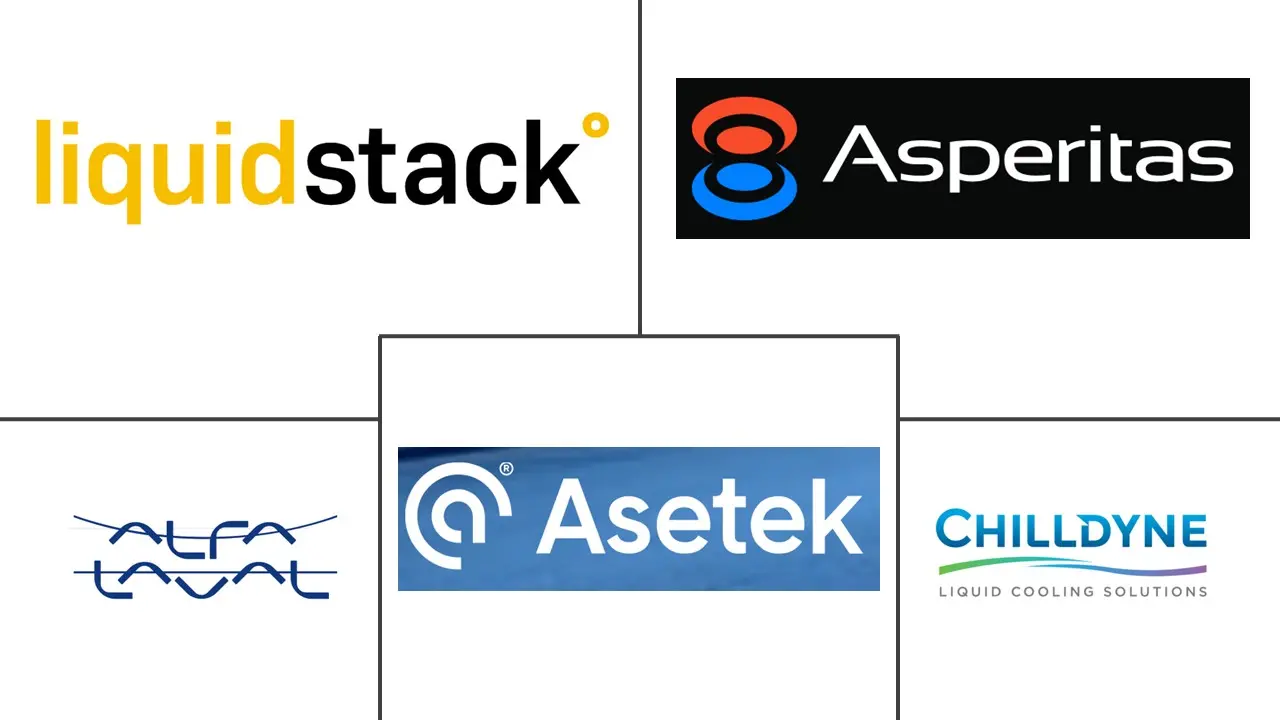Data Center Liquid Cooling Market Size and Share
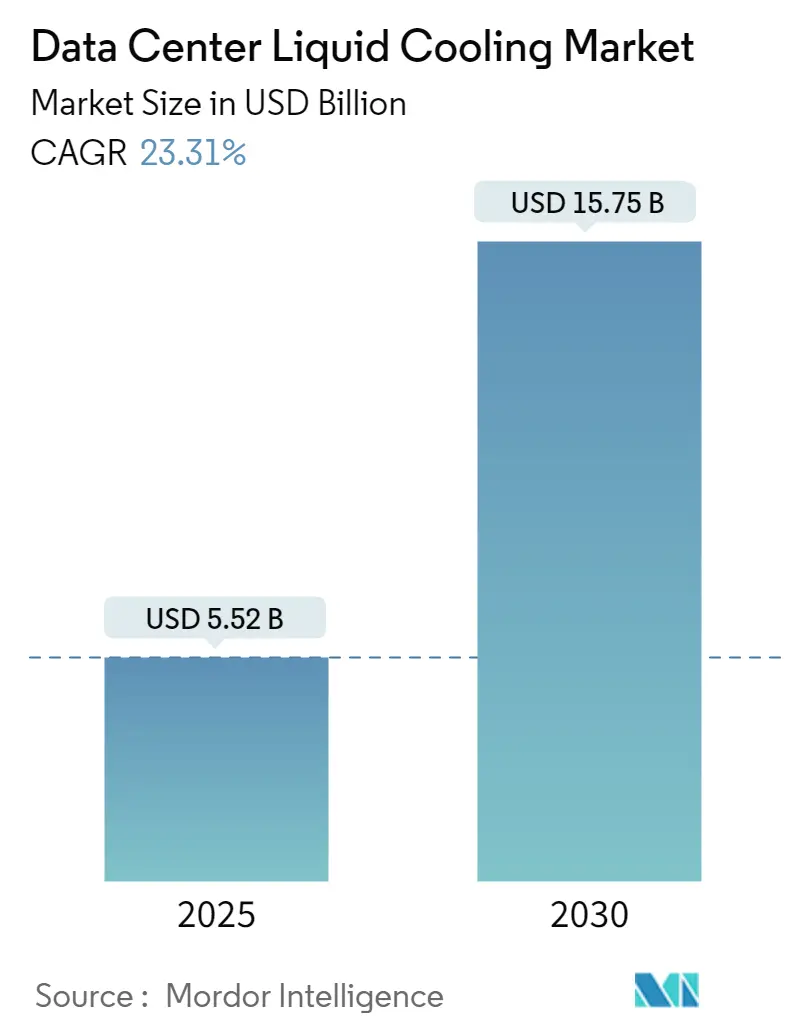
Data Center Liquid Cooling Market Analysis by Mordor Intelligence
The data center liquid cooling market size reached USD 5.52 billion in 2025 and is forecast to reach USD 15.75 billion by 2030, reflecting a 23.31% CAGR. Rising rack densities above 30 kW, the accelerating use of graphics processing units for AI models, and tighter sustainability mandates are converging to make liquid cooling a core architectural requirement for modern facilities. Direct-to-chip solutions continue to dominate because they retrofit into existing racks, while two-phase immersion systems are advancing fastest as operators pursue still higher thermal efficiencies. Hyperscale cloud providers are translating early pilots into fleet-wide rollouts, and their aggregated demand is lowering unit costs for enterprise and colocation buyers. Meanwhile, policy incentives that favour heat re-use and lower carbon intensity are reinforcing liquid adoption across North America, Europe, and selected Asia-Pacific (APAC) hubs.[1]Dan Swinhoe, “Microsoft Adopting Direct-to-Chip Liquid Cooling, Exploring Microfluidics,” Data Center Dynamics, datacenterdynamics.com
Key Report Takeaways
- By cooling technology, direct-to-chip captured 43.33% of the data center liquid cooling market share in 2024; immersion cooling is projected to grow at a 27.50% CAGR through 2030.
- By coolant type, single-phase hydrocarbon fluids accounted for 46.12% of the data center liquid cooling market size in 2024, while two-phase fluorocarbon fluids are set to expand at a 26.33% CAGR.
- By data center type, hyperscale sites led with 39.46% revenue share in 2024; edge and micro data centers are poised for the highest CAGR at 25.79% over 2025-2030.
- By application, AI/ML workloads represented 34.57% of 2024 spending and are expected to advance at a 26.89% CAGR through 2030.
Global Data Center Liquid Cooling Market Trends and Insights
Drivers Impact Analysis
| Driver | (~) % Impact on CAGR Forecast | Geographic Relevance | Impact Timeline |
|---|---|---|---|
| Surging rack densities (>30 kW) in AI and HPC facilities | +6.20% | Global, concentrated in North America and APAC | Short term (≤ 2 years) |
| Hyperscale operators' net-zero roadmaps accelerating liquid adoption | +4.80% | Global, led by North America and Europe | Medium term (2-4 years) |
| OEM warranties now covering direct-to-chip loops | +3.10% | North America and Europe, expanding to APAC | Medium term (2-4 years) |
| Nvidia and AMD liquid-ready reference designs driving ecosystem | +5.40% | Global, strongest in North America and China | Short term (≤ 2 years) |
| Government incentives for green DCs (e.g., EU Taxonomy) underwrite CAPEX | +2.90% | Europe and North America, emerging in APAC | Long term (≥ 4 years) |
| Re-use of waste-heat for district heating monetises OPEX savings | +1.70% | Northern Europe, expanding to North America | Long term (≥ 4 years) |
| Source: Mordor Intelligence | |||
Surging rack densities drive liquid cooling necessity
Data center operators deploying NVIDIA H200 GPUs face 700 W thermal loads per device, and air cooling cannot cost-effectively remove that heat at volume.[2]Uvation Team, “Beyond Sticker Price: How NVIDIA H200 Servers Slash Long-Term TCO,” Uvation, uvation.com With processors delivering up to 1.9 times prior-generation performance, operators can shrink server counts but must dissipate concentrated heat. Liquid cooling, therefore, shifts from an optional efficiency measure to indispensable infrastructure, enabling higher density without blowing past facility power-usage-effectiveness thresholds. The data center liquid cooling market benefits directly because every incremental kilowatt above 20 kW per rack pushes operators toward liquid solutions.
Hyperscale net-zero commitments accelerate adoption
Cloud giants have pledged fleet-wide net-zero emissions and see liquid cooling as a 20% energy-reduction lever compared with legacy air systems. European regulations further require heat recovery from data centers above 1 MW, intensifying uptake of liquid architectures that simplify thermal capture.[3]Max Smolaks, “Heat Reuse: A Management Primer,” Uptime Institute, uptimeinstitute.com These combined voluntary and regulatory forces turn liquid cooling into a compliance infrastructure as well as an operational efficiency strategy, expanding the data center liquid cooling market beyond early adopters.
OEM warranty coverage reduces deployment risk
Server manufacturers now certify entire direct-to-chip loops, eliminating previous concerns about leaks voiding hardware warranties. The policy shift lowers perceived risk and accelerates enterprise spending, broadening the data center liquid cooling industry’s customer base.
Semiconductor reference designs standardize implementation
Nvidia and AMD have published liquid-ready reference boards, simplifying cold-plate alignment and manifold routing. Standardization condenses design cycles for OEM chassis builders and unlocks faster procurement of cooling gear, reinforcing ecosystem maturity.[4]Jingyue Hsiao, “China Fills PFAS-Based Coolant Supply Gap after 3M Exit,” DIGITIMES Asia, digitimes.com
Restraints Impact Analysis
| Restraint | (~) % Impact on CAGR Forecast | Geographic Relevance | Impact Timeline |
|---|---|---|---|
| Limited field expertise among facility engineers | -2.80% | Global, most pronounced in emerging markets | Medium term (2-4 years) |
| High upfront retrofit costs for brown-field sites | -3.40% | Global, particularly in mature markets | Short term (≤ 2 years) |
| Fluid material-compatibility concerns (long-term seals, PCB) | -1.90% | Global, regulatory focus in Europe | Medium term (2-4 years) |
| Supply risk of specialty dielectric fluids | -2.20% | Global, acute in APAC following 3M exit | Short term (≤ 2 years) |
| Source: Mordor Intelligence | |||
Limited field expertise constrains deployment velocity
Liquid systems demand skills in pipe fitting, leak detection, and pump sizing that many legacy data center staff lack. Training programs are expanding, but until the talent pool deepens, roll-out schedules will remain lengthier than air-based projects.
Retrofit costs challenge brown-field adoption
Facilities built for air cooling must retrofit distribution manifolds, secondary loops, and heat-rejection hardware, often matching or exceeding the capex of new shell-and-core builds. This cost headwind slows penetration among enterprise operators with depreciated assets.
Segment Analysis
By Cooling Technology: maturation led by direct-to-chip
Direct-to-chip captured 43.33% of the 2024 data center liquid cooling market share and will continue to anchor short-term growth. Operators favour its drop-in nature for CPUs and moderate-power GPUs. The data center liquid cooling market size for immersion solutions will climb fastest at a 27.50% CAGR, helped by AI training clusters that need extreme heat flux removal. Facilities are increasingly hybrid, using rear-door heat exchangers for moderate racks and immersion baths for GPU islands. Patent filings by Invented and other Taiwanese firms underscore sustained engineering momentum.
A second-order effect is that component suppliers are redesigning pumps, valves, and quick-disconnects to tolerate higher flow rates and non-conductive fluids. As products standardize, procurement cycles shorten and total installed cost falls, reinforcing the technology shift.
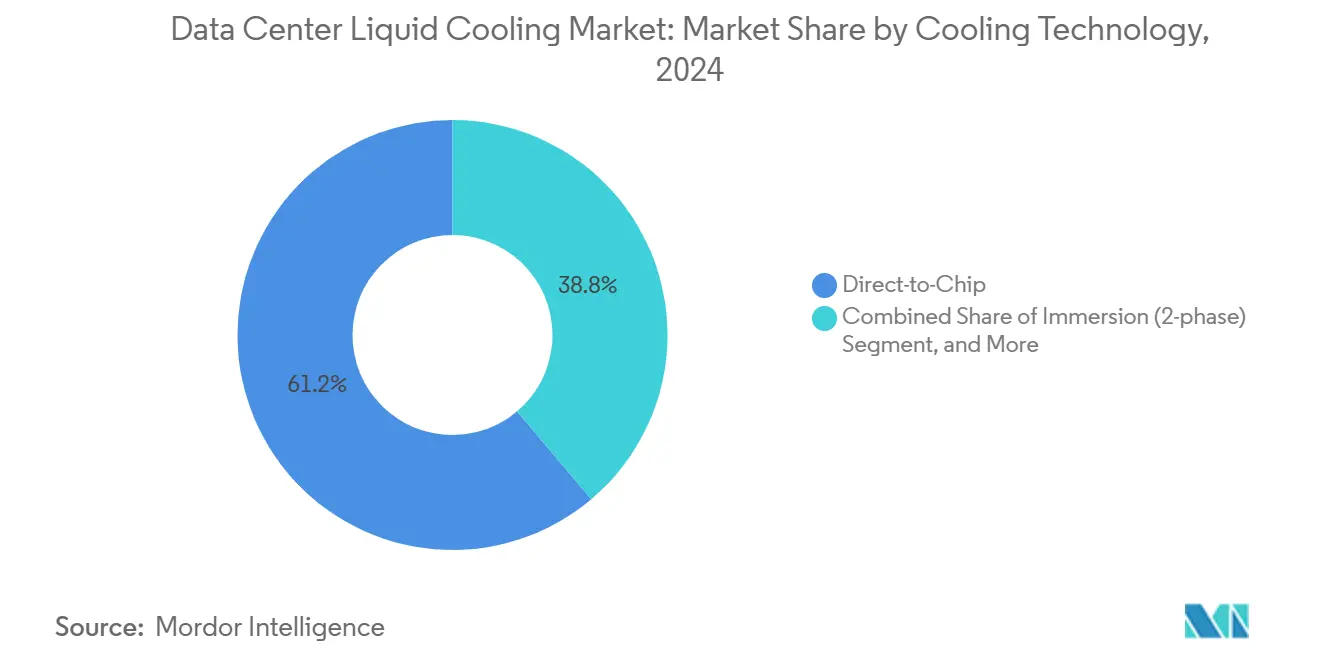
Note: Segment shares of all individual segments available upon report purchase
By Coolant Type: single-phase today, two-phase tomorrow
Single-phase hydrocarbons accounted for the largest slice of the data center liquid cooling market size in 2024 due to mature supply chains. However, two-phase fluorocarbons deliver stronger heat-transfer coefficients and will post a 26.33% CAGR. 3M’s scheduled phase-out of PFAS fluids is reshaping sourcing; Chinese specialty chemical makers are stepping in to backfill demand for semiconductor and server coolant buyers. Governments such as the United Kingdom are funding research into next-generation, low-global-warming-potential fluids, accelerating a broader shift to environmentally aligned chemistries.
Operators are also exploring glycol mixes for facilities where water conservation is paramount. Nanofluids, infused with metal oxides or carbon nanotubes, remain at pilot stage, but test results suggest 10-15% conductivity gains that could unlock thinner cold plates in the coming decade.
By Data Center Type: hyperscale leadership drives edge momentum
Hyperscale players held 39.46% of the market in 2024 and continue to set procurement standards that trickle down to colocation and enterprise tiers. Their heat-reuse pilots, such as the Paris Olympic aquatic center pools heated from a nearby cloud site, showcase demonstrable revenue streams for waste heat. Edge and micro sites will log the highest CAGR at 25.79%, propelled by 5G latency targets and localized AI inference. Compact liquid modules enable 50-70 kW footprints in retail outlets, telecom towers, and manufacturing cells without the noise or airflow constraints of traditional HVAC kits.
As edge footprints spread, service firms specializing in remote liquid maintenance and leak response are emerging, indicating a nascent but critical services sub-segment.
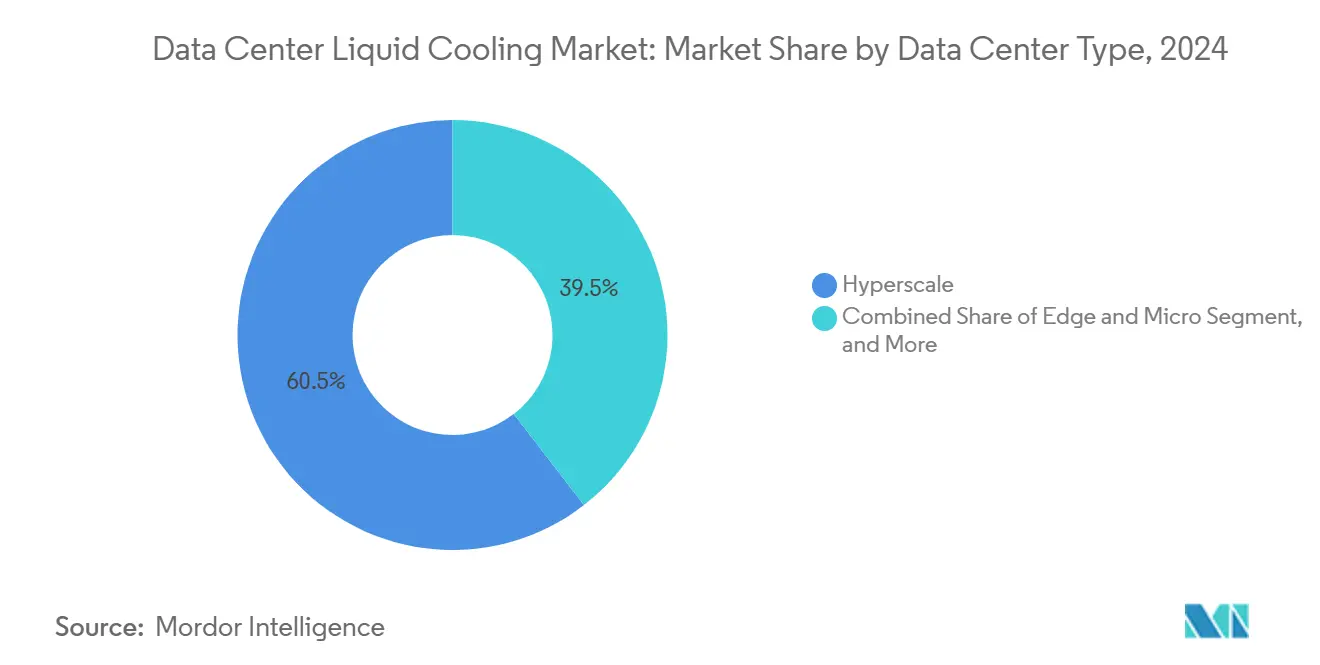
Note: Segment shares of all individual segments available upon report purchase
By Application/Workload: AI/ML dominates spend
AI/ML workloads held 34.57% of 2024 buying and will expand at a 26.89% CAGR, ensuring they remain the single biggest revenue source for the data center liquid cooling market. Model training consumes sustained 30-40 kW per rack, and inference clusters can spike unpredictably, both scenarios straining air paths. High-performance computing for climate modeling and genomic sequencing continues to demand dense GPU farms, while cryptocurrency mining remains opportunistic, clustering where power is lowest cost.
Cloud services are consolidating AI training, inference, virtualization, and storage into unified pods. That convergence creates fluctuating heat profiles, which favour liquid systems that maintain narrow temperature deltas regardless of transient spikes. Suppliers such as Delta Electronics report supply tightness for certain large-loop assemblies, confirming brisk demand.
Geography Analysis
North America preserves its lead position thanks to hyperscale capex and pro-investment tax regimes. Kansas grants 20-year sales-tax holidays on data center spending above USD 250 million, and Massachusetts offers similar exemptions for projects over USD 50 million. The Inflation Reduction Act further augments returns with clean-energy credits, tipping many new builds toward liquid-ready designs.
Europe is the second growth engine. The Energy Efficiency Directive obliges data centers above 1 MW to evaluate heat recovery, and Scandinavian district-heating grids provide an economic off-take route for captured thermal energy. France rewards facilities that prove superior power-usage effectiveness with reduced energy taxes. Collectively, these rules elevate liquid systems from an efficiency choice to a compliance requirement, especially where water-side economizers already exist.
APAC represents the fastest-growing regional slice of the data center liquid cooling market. China is bridging the coolant gap created by 3M’s PFAS exit, while Japan’s utilities incentivize energy-efficient compute nodes. India’s rapid digitalization, supported by dedicated data-center-friendly policies in Telangana and Uttar Pradesh, provides greenfield opportunities to leapfrog directly into liquid architectures. Taiwanese manufacturers, headlined by Inventec, dominate global patent filings and are exporting integrated cold-plate assemblies worldwide.
Africa, Latin America, and the Middle East remain smaller but strategic. Their hot climates and costly power make air systems less attractive, opening niches where compact immersion baths can serve telecom and fintech workloads with minimal mechanical plant.
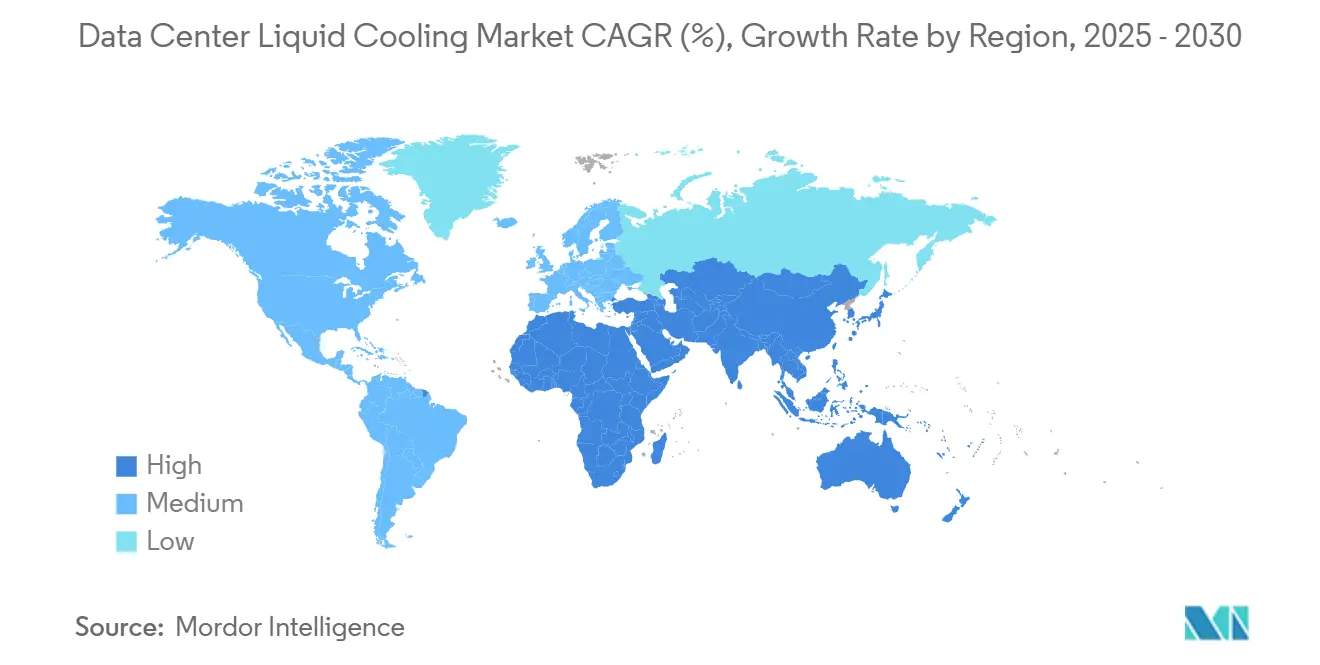
Competitive Landscape
The data center liquid cooling market is moderately fragmented. Schneider Electric, Vertiv, and Alfa Laval extend their HVAC and heat-exchanger portfolios into liquid micro-grids, leveraging channel reach. Specialized vendors such as LiquidStack and CoolIT Systems differentiate on two-phase performance envelopes, while Asetek monetizes decades of desktop PC cooling IP in enterprise rigs. Strategic M&A accelerated: Schneider bought Motivair to secure cold-plate and coolant distribution unit (CDU) technology, and Boyd Corporation acquired Durbin Group to tighten vertical integration.
Patenting momentum remains high; Inventec ranks fourth globally for filed liquid cooling patents, reflecting Asia’s engineering intensity. Yet volatility persists Asetek’s OEM order cancellations in 2024 illustrate that rapid demand shifts can disrupt revenue visibility. Manufacturers that bundle fluids, plates, CDUs, monitoring software, and services into turnkey packages are gaining share because buyers favour simplified procurement.
White-space opportunities include edge-specific sealed immersion boxes, brown-field retrofit kits with minimal downtime, and heat-reuse interface modules that connect to municipal district-heating pipes.
Data Center Liquid Cooling Industry Leaders
-
Alfa Laval Corporate AB
-
LiquidStack Inc.
-
Asetek Inc. A/S
-
Asperitas
-
Chilldyne Inc.
- *Disclaimer: Major Players sorted in no particular order
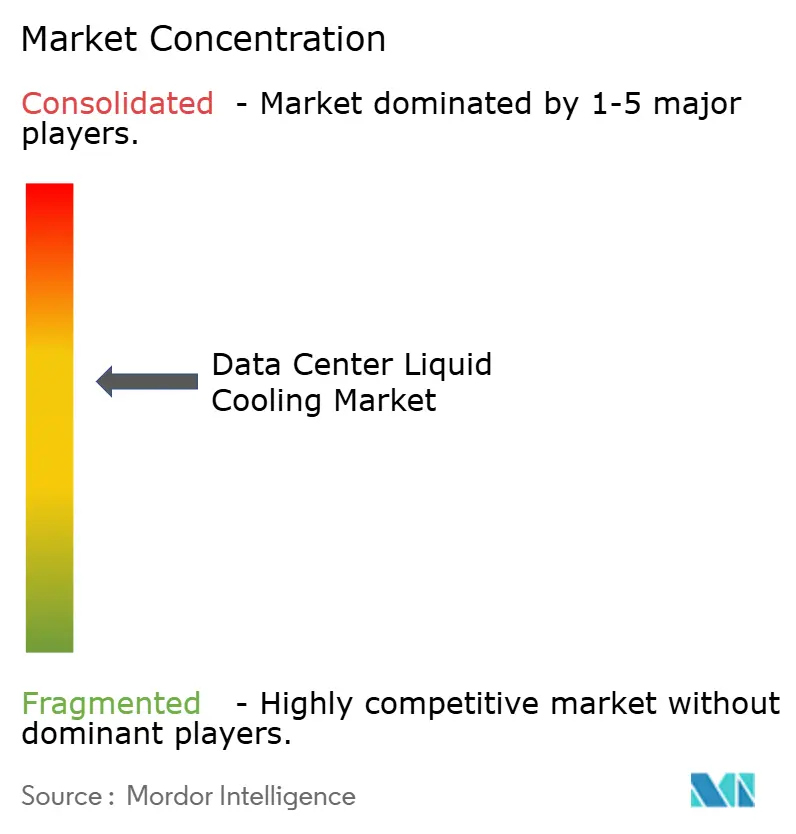
Recent Industry Developments
- August 2025: Daikin acquired server-rack cooling technology to deepen its liquid portfolio.
- August 2025: Giga Storage partnered with Tron-e to develop the Xinpu Tron-e Smart Industrial Park, adding AI-focused cooling solutions.
- July 2025: Microsoft began fleet deployment of direct-to-chip cooling and tested microfluidics inside Azure campuses.
- June 2025: Kaori Heat Treatment projected 2H25 growth on rising CDU demand.
Global Data Center Liquid Cooling Market Report Scope
Data center liquid cooling involves the installation of IT hardware, such as memory, drives, and CPUs, directly into non-conductive dielectric liquids, which cool the system. The heat generated from these systems is directly transferred to coolants, reducing the need for active cooling components, such as heat sinks, fans, and interface materials commonly used for air cooling.
The data center liquid cooling market is segmented by type (indirect or direct-to-chip cooling, direct cooling or immersion cooling, rare door heat exchanger), application (high-performance computing, edge computing, cryptocurrency mining), and geography (North America, Europe, Asia-Pacific, and Rest of the World). The market size and forecasts are provided in terms of value (USD) for all the above segments.
| Immersion Cooling |
| Direct-to-Chip Liquid Cooling |
| Rear-Door Heat Exchangers (RDHx) |
| Cold-Plate / In-row Liquid Systems |
| Single-Phase Hydrocarbon Fluids |
| Two-Phase Fluorocarbon Fluids |
| Water / Glycol Solutions |
| Nanofluids and Other Specialty Liquids |
| Hyperscale |
| Colocation |
| Enterprise / On-Premise |
| Edge and Micro DCs |
| High-Performance Computing (HPC) |
| Artificial Intelligence / Machine Learning |
| Cryptocurrency Mining |
| Cloud and Virtualisation |
| North America | United States | |
| Canada | ||
| South America | Brazil | |
| Rest of South America | ||
| Europe | Germany | |
| United Kingdom | ||
| France | ||
| Netherlands | ||
| Russia | ||
| Rest of Europe | ||
| APAC | China | |
| Japan | ||
| India | ||
| Australia | ||
| Rest of APAC | ||
| Middle East and Africa | Middle East | Saudi Arabia |
| United Arab Emirates | ||
| Africa | South Africa | |
| Rest of MEA | ||
| Segmentation by Cooling Technology | Immersion Cooling | ||
| Direct-to-Chip Liquid Cooling | |||
| Rear-Door Heat Exchangers (RDHx) | |||
| Cold-Plate / In-row Liquid Systems | |||
| Segmentation by Coolant Type | Single-Phase Hydrocarbon Fluids | ||
| Two-Phase Fluorocarbon Fluids | |||
| Water / Glycol Solutions | |||
| Nanofluids and Other Specialty Liquids | |||
| Segmentation by Data Center Type | Hyperscale | ||
| Colocation | |||
| Enterprise / On-Premise | |||
| Edge and Micro DCs | |||
| Segmentation by Application / Workload | High-Performance Computing (HPC) | ||
| Artificial Intelligence / Machine Learning | |||
| Cryptocurrency Mining | |||
| Cloud and Virtualisation | |||
| Segmentation by Geography | North America | United States | |
| Canada | |||
| South America | Brazil | ||
| Rest of South America | |||
| Europe | Germany | ||
| United Kingdom | |||
| France | |||
| Netherlands | |||
| Russia | |||
| Rest of Europe | |||
| APAC | China | ||
| Japan | |||
| India | |||
| Australia | |||
| Rest of APAC | |||
| Middle East and Africa | Middle East | Saudi Arabia | |
| United Arab Emirates | |||
| Africa | South Africa | ||
| Rest of MEA | |||
Key Questions Answered in the Report
How large is the data center liquid cooling market in 2025?
The sector generated USD 5.52 billion in revenue during 2025.
What CAGR is expected for data center liquid cooling between 2025 and 2030?
Revenue is projected to rise at a 23.31% CAGR over the five-year span.
Which cooling technology currently leads adoption?
Direct-to-chip systems hold the largest share at 43.33% of 2024 revenue.
Why are two-phase fluids growing faster than single-phase coolants?
They provide higher heat-transfer coefficients, enabling operators to serve AI racks that exceed 30 kW.
Which data center segment will grow fastest?
Edge and micro facilities are forecast to register the highest CAGR at 25.79% through 2030.
How do regulations influence liquid cooling uptake in Europe?
The EU Energy Efficiency Directive mandates waste-heat recovery for facilities above 1 MW, making liquid cooling an easier compliance path.
Page last updated on:
